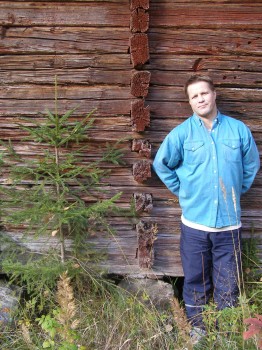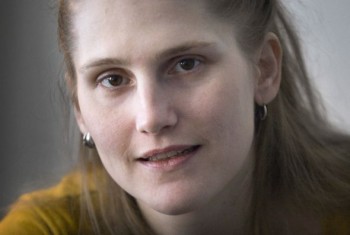Search results for "2010/02/2011/04/2009/10/writing-and-power"
Suvi-Tuuli Junttila: Minne matka, lapanen? [Where are you going, little mitten?]
11 February 2015 | Mini reviews, Reviews
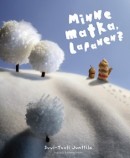 Minne matka, lapanen?
Minne matka, lapanen?
[Where are you going, little mitten?]
Kuvitus [Ill. by]: Suvi-Tuuli Junttila
Helsinki: Schildts & Söderströms, 2014. 57 pp., ill
ISBN 978-951-52-3420-9
€19.90, hardback
Lilla vanten
[Little mitten]
Kuvitus [Ill. by]: Suvi-Tuuli Junttila
Ruotsinnos [Translated into Swedish]: by Jonna Brander
Helsingfors: Schildts & Söderströms, 2014. 57 pp., ill.
ISBN 978-951-52-3460-5
€19.90, hardback
Suvi-Tuuli Junttila’s book combines assemblages and miniatures with winning originality. The exciting journey of the mitten, acorn and bottlecap from autumn to a new spring will inspire creative play and allows young readers to see everyday wonders from a new point of view. Illustration has always been more important than writing for designer and graphic artist Junttila (born 1979) – it is the pictures’ job to create their own story for the viewer. She always places her illustrations in the starring role and gives the text the task of suggestion. Junttila’s previous picture book, Missä, tässä, jossakin (‘Where, here, somewhere’, 2011) won first prize in the Mikkeli illustration triennial.
Translated by Lola Rogers
Leena Krohn: Auringon lapsia [Children of the sun]
16 January 2012 | Mini reviews, Reviews
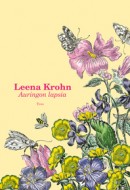 Auringon lapsia
Auringon lapsia
[Children of the sun]
Kuvitus [Ill. by]: Inari Krohn
Helsinki: Teos, 2011. 32 p.
ISBN 978-951-851-311-0
€ 29.40, hardback
It is great news that Leena Krohn has not abandoned the young readership she first addressed through her first book Vihreä vallankumous (‘The green revolution’, 1970), an ecocritical title that also touched on active citizenship. This novel, too, is about the encounter between man and nature. Ten-year-old Orvokki (Violet) is a delivery girl for a florist; like her, the reader is incited to marvel with naive curiosity at life’s various wonders. Krohn is supremely good at writing literature that knows no age limits. Nothing here will go over a child’s head; the essence of the book is accessible to all. In this nicely old-fashioned children’s novel the measured language and expression are pleasing both to the eye and the ear. The hand-coloured graphic prints by the artist (and writer’s sister) Inari Krohn are a homage to Maria Sibylla Merian (1647–1717), the German natural scientist and illustrator who produced life-like paintings of insects and plants.
Translated by Fleur Jeremiah and Emily Jeremiah
New from the archive
9 April 2015 | This 'n' that
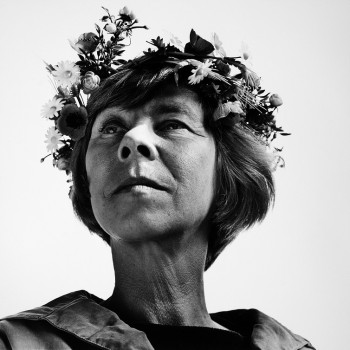
Tove Jansson. Photo: Hans Gedda
After she stopped writing the Moomin stories in 1970, Tove Jansson (1914-2001) began an entirely new career as the author of fiction for adults. This story, ‘Summer child’, comes from her third volume of short stories for adults, Resa med lätt baggage (Travelling light, 1988), where travelling – even if only by motor boat, between the islands of the archipelago that lies off Finland’s south-west coast – is the central theme.
‘Summer child’ tells the story of what happens when Elis, a morbidly serious little boy, spends the summer with a family in the Finnish archipelago. His gloomy world-view disquiets the cheerful Fredriksons to such a degree that in the end their differences can only be settled by violence….
*
The same story is republished, in a different translation, by Sort Of Books of London, with an introduction by the Scottish writer Ali Smith. For Smith, this tale of a young lad, ‘well-informed about everything that’s dying and miserable’, amid the idyllic landscapes of the Finnish summer, is ‘a fable about innocence and knowledge’; the book itself is ‘one of [Jansson’s] funniest, most unputdownably airy works’.
Ali Smith is far from being the only fan of Jansson’s work for adults. Sort Of Books has now published a total of seven volumes of her short stories, memoirs and novels, and her fame has also spread to the United States, where her Moomin books are much less well-known. Her The True Deceiver won the Best Translated Book Award in 2011, and has appeared on Publisher’s Weekly’s list of ‘The 20 Best Books in Translation You’ve Never Read’. It’s in good company – other books include Thomas Bernhard’s Concrete, Knut Hamsun’s Mysterie, Dubravka Ugresic’s The Museum of Unconditional Surrender and George Perec’s Life, A User’s Manual.
Fatherlands, mother tongues?
12 April 2013 | Letter from the Editors
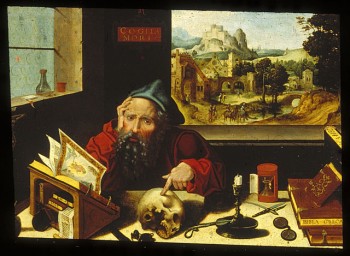
Patron saint of translators: St Jerome (d. 420), translating the Bible into Latin. Pieter Coecke van Aelst, ca 1530. Walters Art Museum, Baltimore. Photo: Wikipedia
Finnish is spoken mostly in Finland, whereas English is spoken everywhere. A Finnish writer, however, doesn’t necessarily write in any of Finland’s three national languages (Finnish, Swedish and Sámi).
What is a Finnish book, then – and (something of particular interest to us here at the Books from Finland offices) is it the same thing as a book from Finland? Let’s take a look at a few examples of how languages – and fatherlands – fluctuate.
Hannu Rajaniemi has Finnish as his mother tongue, but has written two sci-fi novels in English, which were published in England. A Doctor in Physics specialising in string theory, Rajaniemi works at Edinburgh University and lives in Scotland. His books have been translated into Finnish; the second one, The Fractal Prince / Fraktaaliruhtinas (2012) was in March 2013 on fifth place on the list of the best-selling books in Finland. (Here, a sample from his first book, The Quantum Thief, 2011, Gollancz.)
Emmi Itäranta, a Finn who lives in Canterbury, England, published her first novel, Teemestarin tarina (‘The tea master’s book’, Teos, 2012), in Finland. She rewrote it in English and it will be published as Memory of Water in England, the United States and Australia (HarperCollins Voyager) in 2014. Translations into six other languages will follow. More…
Notes for an unwritten autobiography
15 September 2011 | Fiction, Prose
Extracts from the novel William N. Päiväkirja (‘William N. Diary’, Otava, 2011). Interview by Soila Lehtonen
Paris, 15 November 1897
Constance probably bought this notebook for housekeeping purposes, but forgot it when she left, so I shall take it for my use, and I am not going to tear a single page, because the paper is of good quality and the covers are made of calico. When I write in a small hand there is plenty of room for the text, and when I write in Swedish Constance will not understand, if she chances to see the notebook. She has promised to visit once or twice a week and continue to bring food and do the cleaning (we cleared up the differences of opinion that were related to her departure), even though she has now moved and married a retired officer, having been my housekeeper for nearly 30 years. The laundry she has delegated to Madame L., who lives in this house, although that lady is intolerably nosy and talkative, and she has six smutty children. I have decided to write my autobiography, so that posterity shall receive a full and proper impression of my work. (Let Prof. Schwendener from Berlin and Dr Louis Pasteur be content with minor roles!) I shall not begin until tomorrow, for today I intend to study the specimens of South American lichens Prof. D. has sent if there is enough daylight. More…
What’s so great about paper?
17 September 2009 | Articles, Non-fiction
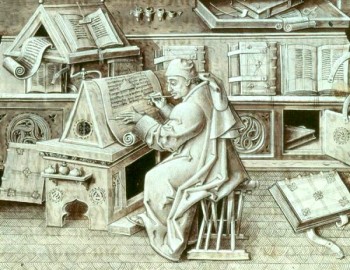
High-tech: the ultimate gadgets of the 15th century, parchment and pen. A portrait of Jean Miélot, the Burgundian author and scribe, by Jan Tavernier (ca. 1456)
The day will soon come when commuters sit on a bus or train with their noses buried in electronic reading devices instead of books or newspapers. Teemu Manninen takes a look at the digital future
Most people interested in books are aware of the arrival of electronic reading devices such as the Amazon Kindle, a kind of iPod — the immensely popular portable music listening device made by the company Apple — for electronic books. For a literary geek like me, the Kindle and e-readers should be the ultimate gadget: a whole library in a small, paperback-sized device. However, I’ve been wondering why digital reading hasn’t become as popular as digital listening. I myself have not invested in an e-reader, although I ought to be exactly the desired kind of customer. After all, I read all the time. Even the mp3 player I have is mostly used for listening to audio books. More…
Heartstone
2 December 2010 | Reviews
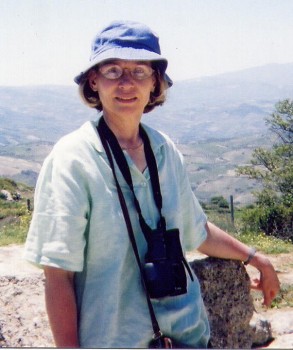
Ulla-Lena Lundberg
‘Knowledge enhances feeling’ is a motto that runs through the whole of Ulla-Lena Lundberg’s oeuvre – both her novels and her travel-writing, covering Åland, Siberia and Africa.
In her trilogy of maritime novels (Leo, Stora världen [‘The wide world’], Allt man kan önska sig [‘All you could wish for’], 1989–1995) she used the form of a family chronicle to depict the development of sea-faring on Åland over the course of a century or so. She gathered her material with historical and anthropological methodology and love of detail. The result was entirely a work of quality fiction, from the consciously old-fashioned rural realism of the first volume to the contradictory postmodern multiplicity of voices in the last – all of it in harmony with the times being depicted.
When Lundberg (born 1947) takes us underground or up onto cliff-faces in her new documentary book, Jägarens leende. Resor i hällkonstens rymd (‘Smile of the hunter. Travels in the space of rock art’), in order to consider cave- and rock-paintings in various parts of the world, she also reveals a little of the background to this attitude towards life that takes such delight in acquiring knowledge – an attitude that is familiar from many of the protagonists of her novels. More…
A thankless task?
24 November 2011 | Letter from the Editors
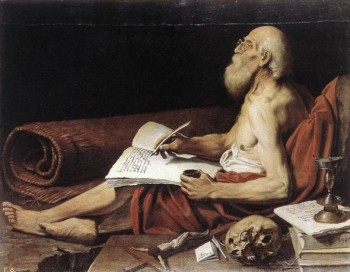
Translator at work: St Jerome, translator of the Latin Bible in the late 4th century, is the patron saint of translators and librarians. Leonello Spada's 1610s painting, Galleria Nazionale d'Arte Antica, Rome. Picture: Wikimedia
Why translate, asked the late Herbert Lomas thirty years ago in an issue of Books from Finland (1/82) – the pay’s absurd, one’s own writing suffers from lack of time, it’s very hard to please people. And public demand for translation from minor languages into English was almost non-existent.
But he also admitted that translating is generally a pleasurable experience: ‘You have the pleasure of writing without the agony of primary invention. It’s like reading, only more so. It’s like writing, only less so.’ More…
The monster reveal’d
31 March 1997 | Archives online, Fiction, Prose
Extracts from the novel Frankensteinin muistikirja (‘Frankenstein’s notebook’, Kirjayhtymä, 1996). Ern(e)st Hemingway and Gertrud(e) Stein – the narrator in these extracts – meet the famous creature in Paris. According to Juha K. Tapio in this, his first novel, Mary Shelley’s monster has been leading an interesting life during the past few centuries
My first impression was that there wasn’t anything particularly monstrous about him. I have already said that his age was hard to determine, but there was something about him that tempted one to apply the word ‘elderly’ to him. He was up in years, no doubt about that, but in a rather special, indefinable way – which made it hard to infer, at least from his outward appearance, what stage he had reached in terms of normal human life. It had to do with something outside of time. He was tall and a little more raw-boned than the average person, and this made one wonder, looking at him, what kind of body his very fashionable clothing concealed his suit and tie conformed to the latest style. This was certainly not the misshapen and monstrous creature I vividly remembered from Mary Shelley’s description.
It was obvious that the past decades had brought about an inevitable evolution. More…
Life: facts and fiction
10 September 2014 | Extracts, Non-fiction
 In his latest book, the architect and author Arne Nevanlinna (born 1925) recalls, among other things, his Helsinki childhood and family, the wartime period, his fellow architect Alvar Aalto, various aspects of the spirit of the times, his own work and writings. His first novel Marie was published in 2008. Extracts from Arne. Oman elämän kintereillä (‘Arne. On the trail of one’s life’, Siltala, 2014)
In his latest book, the architect and author Arne Nevanlinna (born 1925) recalls, among other things, his Helsinki childhood and family, the wartime period, his fellow architect Alvar Aalto, various aspects of the spirit of the times, his own work and writings. His first novel Marie was published in 2008. Extracts from Arne. Oman elämän kintereillä (‘Arne. On the trail of one’s life’, Siltala, 2014)
My attitude to my own identity has developed from the unconsciousness of childhood, the uncertainty of early adulthood, the artificial arrogance of middle age and the self-analysis of approaching retirement, to my present situation.
Despite the fact that my first book had some degree of success, it took many books before I felt I was a real writer. The process continued for well over ten years, by which time I was already over eighty. Before that, I thought of writing as a way to pass the time and combat loneliness. I imagined that I was writing for a living, and that I lived in order to write. I was in the fortunate position of not to think about my income.
Even then, I knew that this was just a catchphrase for the event that it occurred to someone in the audience to ask me why I wrote. That never actually happened. No wonder, as both question and answer would have been unnecessary, to put it mildly, and stupid, to put it harshly. More…

